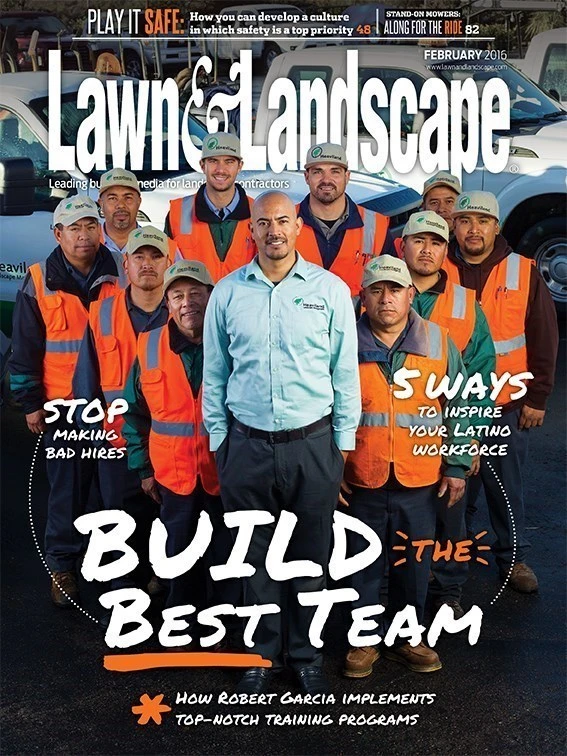Respect and pride are primary motivators for Latino landscapers. By truly engaging them in training, you will see an immediate increase in productivity and retention, and a long-term increase in your bottom line and customer satisfaction.
Without exception, my clients who invest in creating a learning culture are more profitable. We need to sharpen our humans as much as our mower blades.
A quick test.
One of the first questions I ask a new client is: How do you get field employees? If the answer is not, “Our men bring them in,” I know something is not quite right. When crews feel secure and supported, they are proud to bring people in. Some crew leaders stay with companies even when offered more money elsewhere because they feel they are learning and growing with a team who cares about them.
Managers tell me they cannot get their crew members to want to become crew leaders. My question then is: What field and leadership skills are you training them on? Without preparation and training, few people would want to go into a new position. Some companies may not pay the highest wages, yet they have loyal, long-term employees because there is a culture of growth for everyone at the company.
Be proactive.
In progressive companies there are Latino account managers, superintendents, project managers, branch managers, etc. Crew members are much more motivated when they have role models. To increase revenue, take great care of your workforce. The Latino work force needs comprehensive training, recognition for performance and a clear path to move up.
1. Make it interactive.
Every program for landscape employees needs to be highly interactive and industry specific. Examples, exercises and role plays need to be about real, relatable situations.
Often I hear people attempting to train when they are really just “telling.” Trainers ask, “Do you understand?” and of course everyone says yes.
Meet participants where they are. Do not have handouts or PowerPoints up on a screen when field personnel come into training. The majority of our field employees have little formal education. For some, a classroom setting can be intimidating. Let them know right up front, no one will be asked to read unless they volunteer. All exercises with handouts must be done in groups so they can help one another.
Programs need to be very interactive with physical movement. Just mixing them in different small groups keeps things lively.
Showing bueno/no bueno pictures and soliciting their opinions has three benefits:
- The trainer finds out what they do and do not really know.
- Specific points about quality and production techniques are incorporated by the trainer.
- Participants learn from each other, bond and raise self-esteem and mutual respect.
It is also important that the participants are validated. Trainers must be generous with praise for responses, ideas, etc. Most Latino field workers do not receive much recognition. The goal is to make learning fun and exciting. Even quiet workers should be acknowledged.
2. Make it clear.
Managers need to be trained on how to communicate with the field more effectively. It’s tough enough that we are not all speaking the same language. Productivity skyrockets after training all levels of staff to be on the same page. Everyone in a company should receive training on standards of quality, communication techniques, SOPs, discipline with dignity, etc. My clients who reward good safety practices have much better safety records than those who focus on punishing safety violations.
3. Make sure it sticks.
Programs will have a positive transference of learning if the trainers have excellent facilitation skills and good knowledge of the industry and of adult learning techniques.
Trainers need to know how to check for transference of knowledge. They also need to be generous with praise and feedback. Some crew members do like to say that they do not understand. Trainers need to be excellent listeners (not tellers) and ask the who, what, when, where and how questions.
4. Make it quick.
Timing training correctly is essential. The biggest obstacle to training in the landscape industry is finding the time. I believe if you wait to find the time, it will never happen. Training needs to be made a top priority and built right into the schedule.
Keeping managers or field workers in a classroom all day is not recommended. Good trainers will know how to expand or compress landscape and leadership programs as time allows, from a 20-minute tailgate talk to a three-day retreat. Shorter programs that are repeated and duplicated are the most effective.
5. Make it a priority.
To maximize the impact of training, management should get involved, and prepare participants before training. Every boss can take a few moments to ask what the person wants to get out of the training, and state what they want them to gain. The same process occurs when participants return after the off-season.
And don’t forget to stay involved. It means so much to employees to get a handshake and a certificate from a senior leader.
When a management person kicks off a program and “frames” it, participants feel recognized.
At the end of longer training sessions, a management person can pass out the certificate of completion.
Some folks have never been given a certificate for anything in their lives. Those who receive one ask me to have another copy to send home to their mothers.
Get curated news on YOUR industry.
Enter your email to receive our newsletters.
Explore the February 2016 Issue
Check out more from this issue and find your next story to read.
Latest from Lawn & Landscape
- EnP Investments adds Mark McCarel as Northeast territory sales manager
- Our April issue is now live
- Ready or not
- Tribute to an industry guru
- Caterpillar names Christy Pambianchi as chief human resources officer
- Ceramica acquires Fundraising Brick
- Senske Family of Companies acquires Huron Pest Control
- Sunseeker unveils new X7 Series Robotic Mowers






